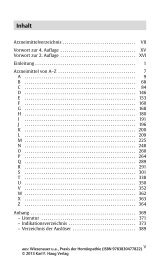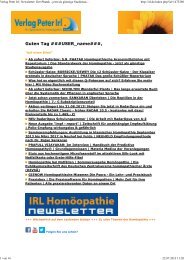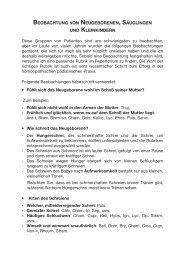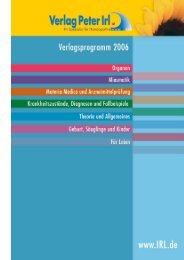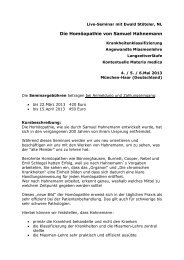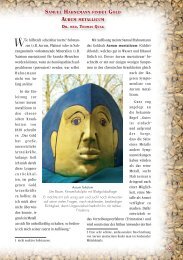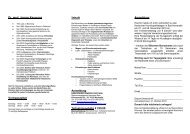The Integrity of Homoeopathy CONTENTS Preface vii Section 1 ...
The Integrity of Homoeopathy CONTENTS Preface vii Section 1 ...
The Integrity of Homoeopathy CONTENTS Preface vii Section 1 ...
Create successful ePaper yourself
Turn your PDF publications into a flip-book with our unique Google optimized e-Paper software.
<strong>CONTENTS</strong><br />
<strong>The</strong> <strong>Integrity</strong> <strong>of</strong> <strong>Homoeopathy</strong><br />
<strong>Preface</strong> <strong>vii</strong><br />
<strong>Section</strong> 1 Miasms, Philosophy & Practice 1<br />
Chronic disease & miasms in homoeopathy 1<br />
<strong>Section</strong> 2 Psora Miasm Characteristics 6<br />
Psoric remedies 12<br />
Psora historically 13<br />
Case 1 Gelsemium 15<br />
Gelsemium characteristics 18<br />
Relationship <strong>of</strong> remedies 19<br />
Gelsemium miasmatic reading 20<br />
Case 2 Picric Acid 22<br />
Picric Acid characteristics and miasmatic reading 24<br />
Picric Acid Philosophy 25<br />
Sulphur characteristics 26<br />
Sulphur history <strong>of</strong> suppressions 29<br />
Sulphur miasmatic reading 30<br />
Relationship <strong>of</strong> remedies 31<br />
Case 3 Sulphuric Acid 32<br />
Sulphuric Acid characteristics 34<br />
Sulphuric Acid miasmatic reading 35<br />
Relationship <strong>of</strong> remedies 36<br />
i
Case 4 Thlaspi Bursa Pastoris 37<br />
Kali Carb 38<br />
Thlaspi Bursa characteristics 39<br />
Relationship <strong>of</strong> remedies 39<br />
Case 5 Valeriana 40<br />
Philosophical comments 41<br />
Sulphur & comments 41<br />
Valeriana characteristics 43<br />
Relationship <strong>of</strong> remedies 44<br />
<strong>Section</strong> 3 Syphilis medical information & comments 45<br />
Syphilitic miasm characteristics 47<br />
Williams Syndrome miasmatic reading 52<br />
Osteo Genesis Imperfecta 54<br />
Aids & syphilis – source: Harris Coulter 55<br />
Syphilinum repertory 57<br />
Syphilinum Burnett 59<br />
Case 1 Mercurius Solubilis 60<br />
Merc Sol characteristics (Farrington) 63<br />
“ children 63<br />
Mercurius Solubilis (Guernsey) 64<br />
Merc Sol & Vivus characteristics 66<br />
Comparisons <strong>of</strong> Merc’s & affinities 68<br />
Relationship <strong>of</strong> remedies chart 70<br />
ii
Case 2 Belladonna – Mercurius Sol. 71<br />
Case 3 Mercurius 74<br />
Case 4 Mercurius Solubis - Merc Vivus 75<br />
Mercurius miasmatic reading 79<br />
Mercurius in acute episodes 80<br />
Philosophical comments 83<br />
Phytolacca 85<br />
Phytolacca characteristics 85<br />
Phytolacca miasmatic reading 87<br />
Relationship <strong>of</strong> remedies chart 88<br />
A Hahnemann Case January 1843 89<br />
Nitric Acid remedy characteristics 91<br />
Miasmatic readings 92<br />
Relationship <strong>of</strong> remedies 93<br />
Case 5 Kali Iodatum 93<br />
Mercurius & Kali Iodatum comments 94<br />
Miasmatic reading <strong>of</strong> Kali Iodatum & affinities to<br />
other Kali’s<br />
Relationship <strong>of</strong> remedies 99<br />
Philosophy on Inbergriff 100<br />
Case 6 Aurum Metallicum 101<br />
Aurum Metallicum characteristics 103<br />
Aur Metallicum miasmatic reading 104<br />
Aurum Muriaticum characteristics & miasmatic<br />
reading<br />
iii<br />
96<br />
105
<strong>Section</strong> 4 Philosophy on the Miasm <strong>of</strong> Sycosis 106<br />
Sycosis miasm 108<br />
Sycosis characteristics & philosophy (from Kent). 112<br />
Sycosis remedies 116<br />
Sycosis medical information. Gonococcus Neissaria 117<br />
Abrotanum characteristics & miasmatic reading 119<br />
Small cases Abrotanum 120<br />
& comments 120<br />
Relationship <strong>of</strong> remedies 121<br />
Case 1 Thuja 122<br />
Thuja Occidentalis characteristics & affinities 125<br />
Relationship <strong>of</strong> remedies 127<br />
Thuja Occidentalis miasmatic reading <strong>of</strong> Thuja 128<br />
Case 2 Natrum Sulphuricum 129<br />
Natrum Sulphuricum characteristics & affinities 131<br />
Miasmatic reading <strong>of</strong> Nat. Sulph. & relationship <strong>of</strong><br />
remedies<br />
iv<br />
133<br />
Case 3 Dulcamara 134<br />
Dulcamara characteristics 136<br />
Relationship <strong>of</strong> remedies 137<br />
Miasmatic reading <strong>of</strong> Dulcamara 138<br />
Sycotic constitution & changing miasms in the case 139<br />
Case 4 Antimonum Crudum 141
Antimonum Crudum Characteristics 144<br />
Relationship <strong>of</strong> remedies 145<br />
Antimonum Crudum miasmatic reading 146<br />
Some Sycotic Remedy Images 147<br />
<strong>Section</strong> 5 Introduction to the Tubercular Miasm<br />
with diagram <strong>of</strong> the miasms<br />
v<br />
150<br />
<strong>The</strong> Tubercular dyscrasia or constitution 152<br />
<strong>The</strong> various Tubercular preparations 153<br />
Case evaluation 154<br />
Case 1 Ipecacuana 157<br />
Case 2 Platinum – Tuberculinum 158<br />
Case 3 Tuberculinum 161<br />
Case 4 Calcarea Phosphorica 162<br />
Calcarea Phosphorica characteristics 164<br />
Characteristics & affinities & relationship <strong>of</strong> remedies 166<br />
Calcarea Phosphorica miasmatic reading 167<br />
Case 5 Stannum – Silica – Tuberculinum 169<br />
Stannum Metallicum characteristics 172<br />
Relationship <strong>of</strong> remedies 173<br />
Miasmatic reading 174<br />
Tubercular in psychopathology (from paper<br />
Barbancy. France 1976)<br />
175
Bacillinum remedy 178<br />
Other references to Bacillinum 180<br />
Other references to Tuberculinum 181<br />
Other preparations <strong>of</strong> Tuberculinum 186<br />
Comparison <strong>of</strong> Bacillinum & Tuberculinum 187<br />
Rubrics containing Tuberculinum (Rent Rep.) 190<br />
Spongia characteristics & affinities 204<br />
Relationship <strong>of</strong> remedies 205<br />
Tubercular remedy image 206<br />
Identifying Tubercular types in case taking 208<br />
Tuberculinum Bovinum & comments 210<br />
Collected tips on the treatment <strong>of</strong> the Tubercular<br />
constitution<br />
If reaction follows the giving <strong>of</strong> Tuberculinum in high<br />
potency<br />
vi<br />
212<br />
214<br />
Psorinum characteristics 215<br />
Relationship <strong>of</strong> remedies 216<br />
Selenium characteristics 217<br />
Relationship <strong>of</strong> remedies 218<br />
Hippozaenium characteristics & relationship <strong>of</strong><br />
remedies<br />
219<br />
Calcarea Iodatum 219<br />
Relationship <strong>of</strong> remedies 220<br />
Catarrhal tuberculosis 221<br />
Tubercular elements in the case: remedy reactions 223
Remedies indicated in early stages <strong>of</strong> Tuberculosis 225<br />
Remedies indicated in later stages <strong>of</strong> Tuberculosis 226<br />
Tuberculinum: A comparison with other remedies 227<br />
Remedies related in treatment <strong>of</strong> Tubercular<br />
conditions<br />
<strong>vii</strong><br />
228<br />
Farrington: Tuberculosis <strong>of</strong> lungs 232<br />
Farrington: other remedies recommended in pre-<br />
Tubercular conditions<br />
Farrington: remedies particularly indicated in the<br />
early/incipient stages <strong>of</strong> TB.<br />
Farrington: remedies particularly indicated in the<br />
later stages <strong>of</strong> Tuberculosis<br />
234<br />
236<br />
237<br />
Case 6 Sulphur – Tuberculinum 239<br />
Conclusion to tubercular constitution 244<br />
CHARTS<br />
Comparison <strong>of</strong> Calc’s <strong>of</strong> great use in clinic work. with<br />
miasmatic references & relationship <strong>of</strong> remedies<br />
Comparison <strong>of</strong> Kali’s with miasmatic references,<br />
affinities & relationship <strong>of</strong> remedies<br />
Comparison <strong>of</strong> Natrum’s with miasmatic references,<br />
affinities<br />
2245<br />
249<br />
256<br />
Conclusion 260<br />
Bibliography 262<br />
Index 265
THE INTEGRITY OF HOMOEOPATHY<br />
MIASMS, PHILOSOPHY AND PRACTICE<br />
Chronic Diseases and Miasms in <strong>Homoeopathy</strong><br />
After over forty five years in practice, I have decided to present my beliefs on<br />
Hahnemann’s concept <strong>of</strong> miasms. From his Chronic Diseases, the Organon, Allen,<br />
Kent and the top three contemporary Jewish sources, I am able to integrate the meaning<br />
<strong>of</strong> miasms into practice – to understand them with reference to remedies, the follow-up<br />
<strong>of</strong> cases and the way they are revealed.<br />
For too many years the miasms have been much maligned or ignored, and, partly<br />
because <strong>of</strong> their adaptation into medical models <strong>of</strong> disease, even <strong>of</strong> psychology, they<br />
are considered unnecessarily complicated if the ideal simillimum is prescribed.<br />
Throughout homoeopathic literature, the miasms have suffered from various names:<br />
“interpretation”; “emanation”; “dyscrasia”; “stigma”; “taint”; “if you believe”. Only a<br />
handful <strong>of</strong> exponents have realised their worth in case taking, treatment, prognosis and<br />
remedy relationships. By using the knowledge <strong>of</strong> hereditary fundamental causes as the<br />
very beginnings <strong>of</strong> an individual’s chronic disease, the symptoms for the simillimum<br />
actually arise from the active miasm, if the case has been properly taken, the totality<br />
achieved, evaluated and repertorised. <strong>The</strong> unravelling <strong>of</strong> a chronic case by the most<br />
similar remedy leads to the follow on, the second or third prescription whenever<br />
necessary, and this involves the activities <strong>of</strong> the unfolding miasm.<br />
After twelve years <strong>of</strong> experience in practice, Hahnemann, dissatisfied with the<br />
relapsing <strong>of</strong> his cases, realised an underlying factor which prevented the most similar<br />
remedy from acting curatively. To him, CURE was not just the removal <strong>of</strong> symptoms,<br />
but the restoration <strong>of</strong> the dynamical balance on all three levels, mental, emotional and<br />
physical, and the ability to maintain this. Hahnemann, in researching hundreds <strong>of</strong> his<br />
cases, formulated the characteristics <strong>of</strong> a pattern. <strong>The</strong> concept was arranged in “a<br />
schematic form until the nature <strong>of</strong> the great miasm became apparent”. (K.P. III). From<br />
his studies PSORA emerged first as the earliest primary disorder <strong>of</strong> the human race,<br />
and the other miasms he discovered later. (Hahnemann, Org. 6 th Edn. transl. William<br />
Boericke, Jain Publishers Ltd, 1989. §78, 79, 80, 81, 82)<br />
Through his cases he found a ‘pattern’, the evolving constitution inherited from past<br />
generations and responsible for a predisposition to certain illnesses. He realised the<br />
present state <strong>of</strong> any illness was only a part <strong>of</strong> this whole process. For the last vestige <strong>of</strong><br />
chronic disease cannot be eradicated without dealing with the fundamental cause, the<br />
inheritance “deeply rooted within the human economy”. (C.M Boger, Collected<br />
Writings, p.40 Churchill Livingstone.)<br />
Through the experience <strong>of</strong> practice it is fully realised each individual has a<br />
characteristic metabolic pattern for “distinctive variations and constitutional factors<br />
must be recognised and considered – these characteristics have been shown to be under<br />
1
THE INTEGRITY OF HOMOEOPATHY<br />
genetic control”. (Harris Coulter, Homoeopathic Science and Modern Medicine<br />
pp.100-101.) <strong>The</strong> miasms affect the personality in diverse forms with reactions to<br />
various remedies and life in general.<br />
Hahnemann conducted his research to find the sequence <strong>of</strong> events, not only<br />
individually, but the framework for mankind’s illnesses. In fact, to find the very<br />
beginnings <strong>of</strong> disease in the human race.<br />
Through my own investigations and study and through discussions with numerous<br />
Jewish scholars, I am <strong>of</strong> the opinion that Hahnemann may have been a Jew.<br />
Homoeopathic principles are elucidated in their entirety in the book Likutei-Amarim -<br />
Tanya which deals with fundamental concepts appearing throughout the writings <strong>of</strong><br />
Hassidism. Hahnemann, with the full comprehension <strong>of</strong> his upbringing, his studies in<br />
ancient Judaism, Hebrew, Aramaic and Greek, and alchemy and as a physician, brought<br />
the spiritual sources and medicine together. From the same sources, as a Greek and<br />
Hebraic scholar, Emanuel Swedenborg, who preceded Hahnemann by forty years,<br />
studied the Kabbalah. He was not a homoeopath or a physician, but a scientist. His<br />
lifetime’s work expounded fully on the dynamic energy <strong>of</strong> all the principles <strong>of</strong><br />
<strong>Homoeopathy</strong> as we know them: Vital Energy; Susceptibility; Hereditary (miasms);<br />
Similars; Succussion; as states <strong>of</strong> consciousness, awareness and the fulfilment <strong>of</strong> the<br />
individual potential.<br />
It is understandable how this study <strong>of</strong> the Old Testament influenced Swedenborg,<br />
Hahnemann and through them James Tyler Kent, E. Farrington and, possibly, Dunham,<br />
through their studies <strong>of</strong> the Old Testament where lie truths <strong>of</strong> homoeopathy manifest in<br />
grades <strong>of</strong> discernment. Various keywords appear in this book such as: “simple<br />
substance”; “degrees”; “potencies”; “life-force”; “cause and effect”; also the emphasis<br />
on “love”; “intelligence”; “wisdom”; “degrees”; “spheres”; “similars”; “potentials”;<br />
“understanding”; “essence” have come to us through their scholarship. Even the<br />
concept <strong>of</strong> the Miasms is present in these classical writings, for the potential <strong>of</strong><br />
anything is in its form.<br />
Miasms are not something material encrusted or added to the complex <strong>of</strong> the human<br />
entity – instead it is the indivisible entity which constitutes man – unsatisfactorily<br />
described as soul energy, spirit, entelechy, simple substance, life matter, energy.<br />
<strong>The</strong> quest for the constitutional basis, the unknown primitive disturbance, was<br />
Hahnemann’s endless search after twelve years <strong>of</strong> countless cases. He considered<br />
genetic inheritance, the fundamental cause, was the great disturber manifesting in<br />
countless ways which he named PSORA, from the Hebraic word “Tsaraath”; the<br />
acceleration and increased intensity <strong>of</strong> which had been produced by heroic medicines,<br />
making inroads into the health <strong>of</strong> the human, and with the iatrogenic diseases<br />
compounding the existing inheritance.<br />
2
THE INTEGRITY OF HOMOEOPATHY<br />
Hahnemann refers a lot to aggressive allopathic treatment suppressing and suspending<br />
the original natural disease while adding a new disease state to the already existing one.<br />
<strong>The</strong> original changing state in mankind was, I consider, <strong>of</strong> a moral and spiritual<br />
disorder, a condition prior to and conducive for the development <strong>of</strong> PSORA. No sense<br />
is made in man diseased from creation, for we can only understand diseases by external<br />
changes and expressions <strong>of</strong> condition. We trace the picture <strong>of</strong> the disease in the<br />
individual as we also trace the beginnings in mankind.<br />
<strong>The</strong> reactive expressions <strong>of</strong> the central disturbance show as a state <strong>of</strong> ‘susceptibility’,<br />
finally resolving into one <strong>of</strong> the great miasms. Allen confirms this repeatedly that to<br />
study the true internal nature <strong>of</strong> disease is to study the miasms.<br />
<strong>The</strong> original changing state was called PSORA making man ‘susceptible to the<br />
environment’ and less adaptive. Hahnemann had discovered the original cause: Health<br />
is adaptability, a balance, the ability to cope, so disease is a fight for health and not a<br />
surrender. <strong>The</strong> keywords are SUSCEPTIBILITY and REACTION as the living<br />
organism increasingly reacts to the environment and reactions produce symptoms.<br />
Understanding this should give us a clear insight meaningful to Hahnemann’s<br />
endeavours in explaining the ‘beginnings’ called PSORA by him. <strong>The</strong> allopaths even<br />
at that time in history were searching for causes in their explanations <strong>of</strong> the humours <strong>of</strong><br />
the body. Too much blood or too much phlegm or too little. None <strong>of</strong> these systems<br />
were in ‘consonance with nature’ for drastic means were employed to rid the body <strong>of</strong><br />
such causes.<br />
Hahnemann’s belief in the life force, the dynamic nature <strong>of</strong> health and disease ever<br />
present in delicate balance, was his conviction that PSORA is constantly within us. Its<br />
characteristic anxieties and fears are typical. Through the aeons <strong>of</strong> time and<br />
individually it is systemic. It permeates the whole organism, and what is in mankind is<br />
also reflected in nature. <strong>The</strong> whole organism is interrelated, each symptom relates to<br />
the whole. PSORA the original disturber produces its own array <strong>of</strong> physical symptoms,<br />
gradually manifesting into pathological conditions. In PSORA the functional<br />
disturbances predominate, but it is the common wellspring <strong>of</strong> the other miasms.<br />
<strong>The</strong> entire constitution <strong>of</strong> the individual is altered. ‘Susceptibility is the major and<br />
interesting factor in the health equation’. Why will some members <strong>of</strong> a family come<br />
down with an epidemic or virus and the other members <strong>of</strong> the family remain immune?’<br />
It is for this reason why Kent reiterates Hahnemann that Psora is the beginning <strong>of</strong> all<br />
physical sickness, as the changing state <strong>of</strong> susceptibility <strong>The</strong> other two miasms would<br />
not have been possible, and there would be no acutes. It progresses from the simple to<br />
the highest degree <strong>of</strong> complexity ‘not alone by itself’ but by ‘generation after<br />
generation <strong>of</strong> drugging’. <strong>The</strong> root <strong>of</strong> the trouble is the underlying PSORA. What can<br />
3
THE INTEGRITY OF HOMOEOPATHY<br />
be said <strong>of</strong> the drugging <strong>of</strong> the twenty first century? <strong>The</strong> concept <strong>of</strong> chronic disease is<br />
an extremely important part in the Homoeopathic therapeutics.<br />
Skin eruptions became one <strong>of</strong> the earliest signs observable <strong>of</strong> PSORA. Ancient<br />
literature and biblical references are rife with the description <strong>of</strong> skin lesions. Each type<br />
had a name, from burning to dryness to itching. Hahnemann uses the word “infection”<br />
but in Org §148 he states PSORA as a “kind <strong>of</strong> infection”. This was prior to the<br />
discovery <strong>of</strong> germs and bacteria. <strong>The</strong> word ‘infection’ from the dictionary enlightens<br />
us: “to stain, to spoil, to taint with moral corruption, to deprave, to affect person, body,<br />
mind with disease”.<br />
Reading Hahnemann’s CHRONIC DISEASES under PSORA, it seems every disease<br />
was attributable to it. But I would like to mention here, as Hahnemann discovered,<br />
later miasms <strong>of</strong> Syphilis and Sycosis thus miasmatic analysis becomes more complex.<br />
Simple PSORA was complicated by centuries <strong>of</strong> suppressive external treatment. It<br />
does not make sense as PSORA was leprosy as stated in some books. This was<br />
probably due to the word ‘leprae’ translated as PSORA. Leprosy, as we know, is<br />
destructive tissue, and would therefore come under the destructive miasm <strong>of</strong> syphilis,<br />
which appeared later in time.<br />
<strong>The</strong> appearance <strong>of</strong> skin eruptions in a chronic form has been considered as naturally<br />
curative, as mentioned before even skin lesions are systemic. <strong>The</strong> appearance <strong>of</strong><br />
exanthematous diseases as chicken pox or measles or scarlatina are ‘active explosions<br />
<strong>of</strong> latent psora’. <strong>The</strong>y should be allowed to find expression through the skin and not<br />
leapt upon as dangerous. Suppress these external outlets and numerous chronic<br />
diseases manifest. Do we work with nature in assisting this outlet for the life force or<br />
are we trying to control it – asthma we know today is a frequent consequence <strong>of</strong><br />
suppression. To understand this further, we may read the side effects or adverse<br />
reactions to drugs used in the treatment <strong>of</strong> skin disorders. “Iatrogenic disease is being<br />
converted into chronic disease.”<br />
All the miasms exist in latency or activity throughout one’s lifetime but especially<br />
PSORA. <strong>The</strong>y appear or reappear in activity according to ‘exciting or maintaining<br />
causes’. Our circumstances and environment are always with us. But the ‘fundamental<br />
miasm’ to which we relapse ever and again is PSORA.<br />
“All the imitations <strong>of</strong> miasms are found - in the animal, vegetable and mineral<br />
kingdoms”. <strong>The</strong> imitations <strong>of</strong> their image are found in each <strong>of</strong> our remedies. As such<br />
then we can learn to apply them by relating them to the image <strong>of</strong> a miasm seen in the<br />
patient. This is called ‘individualisation’ and the ‘Classical way to proceed’.<br />
<strong>The</strong> question <strong>of</strong>ten asked, but is it necessary to know about the chronic miasms in order<br />
to treat? In chronic constitutional illnesses, the homoeopathic practitioner “is a<br />
preserver <strong>of</strong> health, if he knows the things that derange health and cause disease”. In<br />
4
THE INTEGRITY OF HOMOEOPATHY<br />
order to cure disease intelligently we must take note <strong>of</strong> ‘fundamental cause’ ‘generally<br />
due to a chronic miasm’. How may the Homoeopath follow the evolution <strong>of</strong> the<br />
curative process unless the basic active miasms are known? To chase separate<br />
symptoms without relating them to the whole case is symptomatic treatment. <strong>The</strong><br />
nature <strong>of</strong> the chronic uppermost miasm makes itself known. <strong>The</strong> more miasms which<br />
exist in a patient, the more complex and difficult is finding the simillimum. <strong>The</strong><br />
totality is comprised by the symptom image reflected from the ‘internal essence’ <strong>of</strong> the<br />
disturbed vital force. We as practitioners search for this reflected image in the disease<br />
picture. For the remedy may reflect psora, syphilis, sycosis, tubercular or the<br />
combination <strong>of</strong> these.<br />
A ‘knowledge <strong>of</strong> the active miasm’ – ‘assists us in choosing a remedy from a few <strong>of</strong><br />
them which appear in the working <strong>of</strong> a case’. <strong>The</strong> second prescription will cover the<br />
latent miasm <strong>of</strong> symptoms now disturbed and brought into action by the active miasm,<br />
on which the first prescription was based, as the reader will see in some <strong>of</strong> the cases<br />
included in this book.<br />
5




